Consequences of Surface Composition and Aggregation Conditions of Ag Nanoparticles on Surface-Enhanced Raman Scattering (SERS) of Pesticides
Abstract
1. Introduction
2. Materials and Methods
2.1. AgH and AgCT Synthesis
2.2. SERS, UV-Vis, DLS and Zeta Potential Measurements
3. Results and Discussion
3.1. SERS of TBZ and MBC Using AgH and Salts
3.2. AgH Aggregation in the Presence of Salts, TBZ and MBC
3.3. SERS of TBZ and MBC Using AgCT and Salts
3.4. AgCT Aggregation in the Presence of Salts, TBZ and MBC
4. Conclusions
Supplementary Materials
Author Contributions
Funding
Institutional Review Board Statement
Informed Consent Statement
Data Availability Statement
Acknowledgments
Conflicts of Interest
References
- Long, Z.; Wang, X.; Wang, Y.; Dai, H.; Li, C.; Xue, Y.; Deng, Y.; Zhang, H.; Yu, Y.; Fang, H. Characterization of a Novel Carbendazim-Degrading Strain Rhodococcus sp. CX-1 Revealed by Genome and Transcriptome Analyses. Sci. Total Environ. 2021, 754, 142137. [Google Scholar] [CrossRef]
- Wang, M.; Zhu, W.; Zhao, L.; Jin, J.; Song, Y.; Liu, M. Simultaneous Detection of Thiabendazole and Carbendazim in Foods Based on Two-Color Upconversion and Magnetic Separation Nanoparticles Fluorescence Immunoassay. Eur. Food Res. Technol. 2022, 248, 85–94. [Google Scholar] [CrossRef]
- Zhu, Y.; Zhang, Y.; Liu, N.; Ren, W.; Hou, Y.; Duan, Y.; Song, X.; Zhou, M. The Dis1/Stu2/XMAP215 Family Gene FgStu2 Is Involved in Vegetative Growth, Morphology, Sexual and Asexual Reproduction, Pathogenicity and DON Production of Fusarium Graminearum. Front. Microbiol. 2020, 11, 545015. [Google Scholar] [CrossRef] [PubMed]
- Constantino, C.J.L.; Lemma, T.; Antunes, P.A.; Aroca, R. Single-Molecule Detection Using Surface-Enhanced Resonance Raman Scattering and Langmuir−Blodgett Monolayers. Anal. Chem. 2001, 73, 3674–3678. [Google Scholar] [CrossRef] [PubMed]
- Le Ru, E.C.; Etchegoin, P.G. Single-Molecule Surface-Enhanced Raman Spectroscopy. Annu. Rev. Phys. Chem. 2012, 63, 65–87. [Google Scholar] [CrossRef]
- Lombardi, J.R. The Theory of Surface-Enhanced Raman Scattering on Semiconductor Nanoparticles; toward the Optimization of SERS Sensors. Faraday Discuss. 2017, 205, 105–120. [Google Scholar] [CrossRef]
- Mahanty, S.; Majumder, S.; Paul, R.; Boroujerdi, R.; Valsami-Jones, E.; Laforsch, C. A Review on Nanomaterial-Based SERS Substrates for Sustainable Agriculture. Sci. Total Environ. 2024, 950, 174252. [Google Scholar] [CrossRef] [PubMed]
- Dong, X.; Gu, H.; Kang, J.; Yuan, X.; Wu, J. Comparative Study of Surface-Enhanced Raman Scattering Activities of Three Kinds of Silver Colloids When Adding Anions as Aggregating Agents. Colloids Surf. A Physicochem. Eng. Asp. 2010, 368, 142–147. [Google Scholar] [CrossRef]
- De, S.; Pal, A.; Jana, N.R.; Pal, T. Anion Effect in Linear Silver Nanoparticle Aggregation as Evidenced by Efficient Fluorescence Quenching and SERS Enhancement. J. Photochem. Photobiol. A Chem. 2000, 131, 111–123. [Google Scholar] [CrossRef]
- Izquierdo-Lorenzo, I.; Alda, I.; Sanchez-Cortes, S.; Garcia-Ramos, J.V. Adsorption and Detection of Sport Doping Drugs on Metallic Plasmonic Nanoparticles of Different Morphology. Langmuir 2012, 28, 8891–8901. [Google Scholar] [CrossRef] [PubMed]
- Futamata, M.; Maruyama, Y. Electromagnetic and Chemical Interaction between Ag Nanoparticles and Adsorbed Rhodamine Molecules in Surface-Enhanced Raman Scattering. Anal. Bioanal. Chem. 2007, 388, 89–102. [Google Scholar] [CrossRef] [PubMed]
- Futamata, M.; Yu, Y.; Yajima, T. Elucidation of Electrostatic Interaction between Cationic Dyes and Ag Nanoparticles Generating Enormous SERS Enhancement in Aqueous Solution. J. Phys. Chem. C 2011, 115, 5271–5279. [Google Scholar] [CrossRef]
- Mostowtt, T.; Munoz, J.; McCord, B. An Evaluation of Monovalent, Divalent, and Trivalent Cations as Aggregating Agents for Surface Enhanced Raman Spectroscopy (SERS) Analysis of Synthetic Cannabinoids. Analyst 2019, 144, 6404–6414. [Google Scholar] [CrossRef]
- Burns, C.; Spendel, W.; Puckett, S.; Pacey, G. Solution Ionic Strength Effect on Gold Nanoparticle Solution Color Transition. Talanta 2006, 69, 873–876. [Google Scholar] [CrossRef] [PubMed]
- Khrushchev, A.Y.; Akmaev, E.R.; Gulyaeva, A.Y.; Zavialov, A.; Sidorenko, A.I.; Bondarenko, V.O.; Lvovskiy, A.I. Ion-Induced Agglomeration of Ag NPs for Quantitative Determination of Trace Malachite Green in Natural Water by SERS. Vib. Spectrosc. 2022, 120, 103360. [Google Scholar] [CrossRef]
- Leopold, N.; Lendl, B. A New Method for Fast Preparation of Highly Surface-Enhanced Raman Scattering (SERS) Active Silver Colloids at Room Temperature by Reduction of Silver Nitrate with Hydroxylamine Hydrochloride. J. Phys. Chem. B 2003, 107, 5723–5727. [Google Scholar] [CrossRef]
- Garcia-Leis, A.; Rivera-Arreba, I.; Sanchez-Cortes, S. Morphological Tuning of Plasmonic Silver Nanostars by Controlling the Nanoparticle Growth Mechanism: Application in the SERS Detection of the Amyloid Marker Congo Red. Colloids Surf. A Physicochem. Eng. Asp. 2017, 535, 49–60. [Google Scholar] [CrossRef]
- Lee, P.C.; Meisel, D. Adsorption and Surface-Enhanced Raman of Dyes on Silver and Gold Sols. J. Phys. Chem. 1982, 86, 3391–3395. [Google Scholar] [CrossRef]
- Orendorff, C.J.; Gole, A.; Sau, T.K.; Murphy, C.J. Surface-Enhanced Raman Spectroscopy of Self-Assembled Monolayers: Sandwich Architecture and Nanoparticle Shape Dependence. Anal. Chem. 2005, 77, 3261–3266. [Google Scholar] [CrossRef]
- Brezestean, I.A.; Tosa, N.; Falamas, A.; Cuibus, D.; Muntean, C.M.; Bende, A.; Cozar, B.; Berghian-Grosan, C.; Farcău, C. Silver Nanoparticle Films Obtained by Convective Self-Assembly for Surface-Enhanced Raman Spectroscopy Analyses of the Pesticides Thiabendazole and Endosulfan. Front. Chem. 2022, 10, 915337. [Google Scholar] [CrossRef] [PubMed]
- Muniz-Miranda, M. SERS Investigation on Five-Membered Heterocyclic Compounds: Isoxazole, Oxazole and Thiazole. Vib. Spectrosc. 1999, 19, 227–232. [Google Scholar] [CrossRef]
- Müller, C.; David, L.; Chiş, V.; Pînzaru, S.C. Detection of Thiabendazole Applied on Citrus Fruits and Bananas Using Surface Enhanced Raman Scattering. Food Chem. 2014, 145, 814–820. [Google Scholar] [CrossRef] [PubMed]
- Oliveira, M.J.S.; Rubira, R.J.G.; Furini, L.N.; Batagin-Neto, A.; Constantino, C.J.L. Detection of Thiabendazole Fungicide/Parasiticide by SERS: Quantitative Analysis and Adsorption Mechanism. Appl. Surf. Sci. 2020, 517, 145786. [Google Scholar] [CrossRef]
- Furini, L.N.; Constantino, C.J.L.; Sanchez-Cortes, S.; Otero, J.C.; López-Tocón, I. Adsorption of Carbendazim Pesticide on Plasmonic Nanoparticles Studied by Surface-Enhanced Raman Scattering. J. Colloid Interface Sci. 2016, 465, 183–189. [Google Scholar] [CrossRef] [PubMed]
- Roldán, M.L.; Corrado, G.; Francioso, O.; Sanchez-Cortes, S. Interaction of Soil Humic Acids with Herbicide Paraquat Analyzed by Surface-Enhanced Raman Scattering and Fluorescence Spectroscopy on Silver Plasmonic Nanoparticles. Anal. Chim. Acta 2011, 699, 87–95. [Google Scholar] [CrossRef]
- Guerrini, L.; Garcia-Ramos, J.V.; Domingo, C.; Sanchez-Cortes, S. Nanosensors Based on Viologen Functionalized Silver Nanoparticles: Few Molecules Surface-Enhanced Raman Spectroscopy Detection of Polycyclic Aromatic Hydrocarbons in Interparticle Hot Spots. Anal. Chem. 2009, 81, 1418–1425. [Google Scholar] [CrossRef]
- Khlebtsov, B.N.; Khanadeev, V.A.; Panfilova, E.V.; Bratashov, D.N.; Khlebtsov, N.G. Gold Nanoisland Films as Reproducible SERS Substrates for Highly Sensitive Detection of Fungicides. ACS Appl. Mater. Interfaces 2015, 7, 6518–6529. [Google Scholar] [CrossRef] [PubMed]
- Futamata, M.; Yu, Y.-Y.; Yanatori, T.; Kokubun, T. Closely Adjacent Ag Nanoparticles Formed by Cationic Dyes in Solution Generating Enormous SERS Enhancement. J. Phys. Chem. C 2010, 114, 7502–7508. [Google Scholar] [CrossRef]
- Bhattacharjee, S. DLS and Zeta Potential—What They Are and What They Are Not? J. Control. Release 2016, 235, 337–351. [Google Scholar] [CrossRef] [PubMed]
- Chen, Q.; Zuo, J.; He, X.; Mo, X.; Tong, P.; Zhang, L. Enhanced Fluorescence of Terbium with Thiabendazole and Application in Determining Trace Amounts of Terbium and Thiabendazole. Talanta 2017, 162, 540–546. [Google Scholar] [CrossRef] [PubMed]
- Aroca, R. Surface-Enhanced Vibrational Spectroscopy; John Wiley & Sons, Ltd.: Chichester, UK, 2006; ISBN 9780470035641. [Google Scholar]
- Aroca, R.F.; Vallete, M.C.; Ramos, J.V.G.; Sanchez Cortés, S.; Sanchez Gil, J.A.; Sevilla, P. Amplificacion Plasmonica de Espectros Raman y de Fluorescencia, SERS y SEF Sobre Nanoestructuras Metálicas; CSIC: Madrid, Spain, 2014. [Google Scholar]
- Oncsik, T.; Trefalt, G.; Borkovec, M.; Szilagyi, I. Specific Ion Effects on Particle Aggregation Induced by Monovalent Salts within the Hofmeister Series. Langmuir 2015, 31, 3799–3807. [Google Scholar] [CrossRef] [PubMed]
- López-León, T.; Santander-Ortega, M.J.; Ortega-Vinuesa, J.L.; Bastos-González, D. Hofmeister Effects in Colloidal Systems: Influence of the Surface Nature. J. Phys. Chem. C 2008, 112, 16060–16069. [Google Scholar] [CrossRef]
- Merk, V.; Rehbock, C.; Becker, F.; Hagemann, U.; Nienhaus, H.; Barcikowski, S. In Situ Non-DLVO Stabilization of Surfactant-Free, Plasmonic Gold Nanoparticles: Effect of Hofmeister’s Anions. Langmuir 2014, 30, 4213–4222. [Google Scholar] [CrossRef]
- López-León, T.; Ortega-Vinuesa, J.L.; Bastos-González, D. Ion-Specific Aggregation of Hydrophobic Particles. ChemPhysChem 2012, 13, 2382–2391. [Google Scholar] [CrossRef] [PubMed]
- Furini, L.N.; Sanchez-Cortes, S.; López-Tocón, I.; Otero, J.C.; Aroca, R.F.; Constantino, C.J.L. Detection and Quantitative Analysis of Carbendazim Herbicide on Ag Nanoparticles via Surface-Enhanced Raman Scattering. J. Raman Spectrosc. 2015, 46, 1095–1101. [Google Scholar] [CrossRef]
- Mazellier, P.; Leroy, É.; Legube, B. Photochemical Behavior of the Fungicide Carbendazim in Dilute Aqueous Solution. J. Photochem. Photobiol. A Chem. 2002, 153, 221–227. [Google Scholar] [CrossRef]
- Munro, C.H.; Smith, W.E.; Garner, M.; Clarkson, J.; White, P.C. Characterization of the Surface of a Citrate-Reduced Colloid Optimized for Use as a Substrate for Surface-Enhanced Resonance Raman Scattering. Langmuir 1995, 11, 3712–3720. [Google Scholar] [CrossRef]
- Alvarez-Puebla, R.A.; Arceo, E.; Goulet, P.J.G.; Garrido, J.J.; Aroca, R.F. Role of Nanoparticle Surface Charge in Surface-Enhanced Raman Scattering. J. Phys. Chem. B 2005, 109, 3787–3792. [Google Scholar] [CrossRef]
- Lu, Z.; Gu, Y.; Yang, J.; Li, Z.; Ruan, W.; Xu, W.; Zhao, C.; Zhao, B. SERS-Active Ag Substrate from the Photo-Active Decomposition of Electrodeposited Divalent Silver Oxide. Vib. Spectrosc. 2008, 47, 99–104. [Google Scholar] [CrossRef]
- Futamata, M.; Maruyama, Y. LSP Spectral Changes Correlating with SERS Activation and Quenching for R6G on Immobilized Ag Nanoparticles. Appl. Phys. B 2008, 93, 117–130. [Google Scholar] [CrossRef]
- Rubira, R.J.G.; Furini, L.N.; Constantino, C.J.L.; Sanchez-Cortes, S. SERS Detection of Prometryn Herbicide Based on Its Optimized Adsorption on Ag Nanoparticles. Vib. Spectrosc. 2021, 114, 103245. [Google Scholar] [CrossRef]
- Waterhouse, G.I.N.; Bowmaker, G.A.; Metson, J.B. Oxygen Chemisorption on an Electrolytic Silver Catalyst: A Combined TPD and Raman Spectroscopic Study. Appl. Surf. Sci. 2003, 214, 36–51. [Google Scholar] [CrossRef]
- Rivas, L.; Sanchez-Cortes, S.; García-Ramos, J.V.; Morcillo, G. Growth of Silver Colloidal Particles Obtained by Citrate Reduction to Increase the Raman Enhancement Factor. Langmuir 2001, 17, 574–577. [Google Scholar] [CrossRef]
- Pillai, Z.S.; Kamat, P.V. What Factors Control the Size and Shape of Silver Nanoparticles in the Citrate Ion Reduction Method? J. Phys. Chem. B 2004, 108, 945–951. [Google Scholar] [CrossRef]
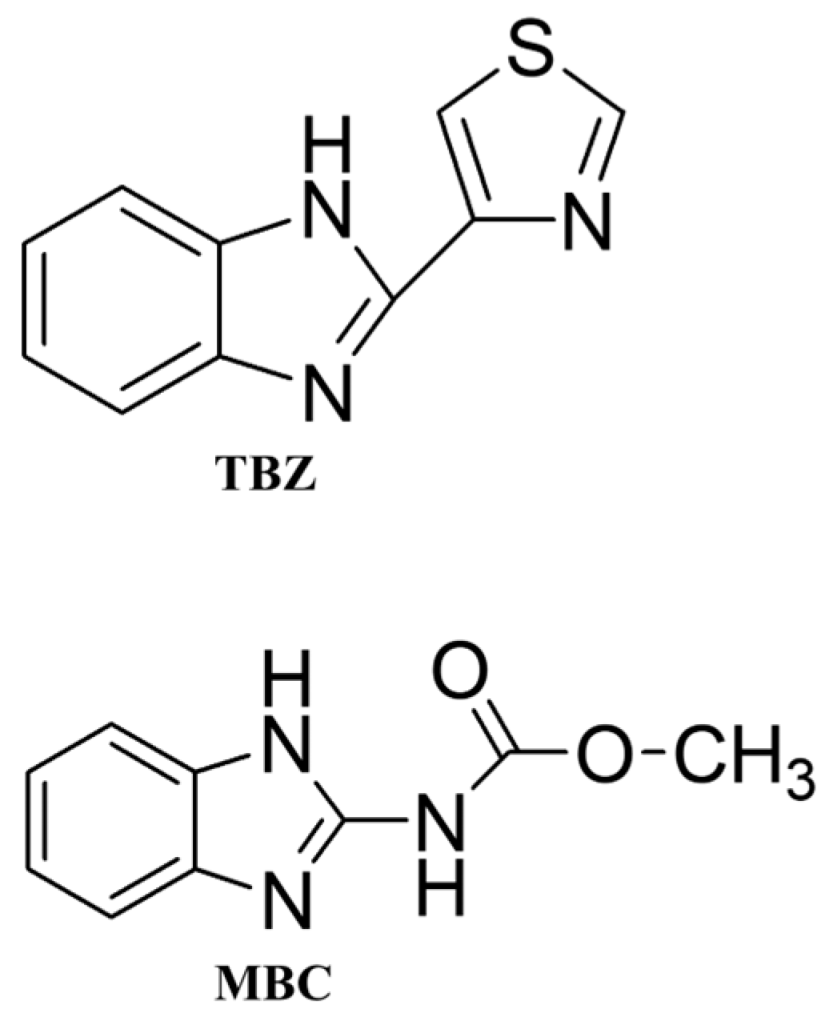

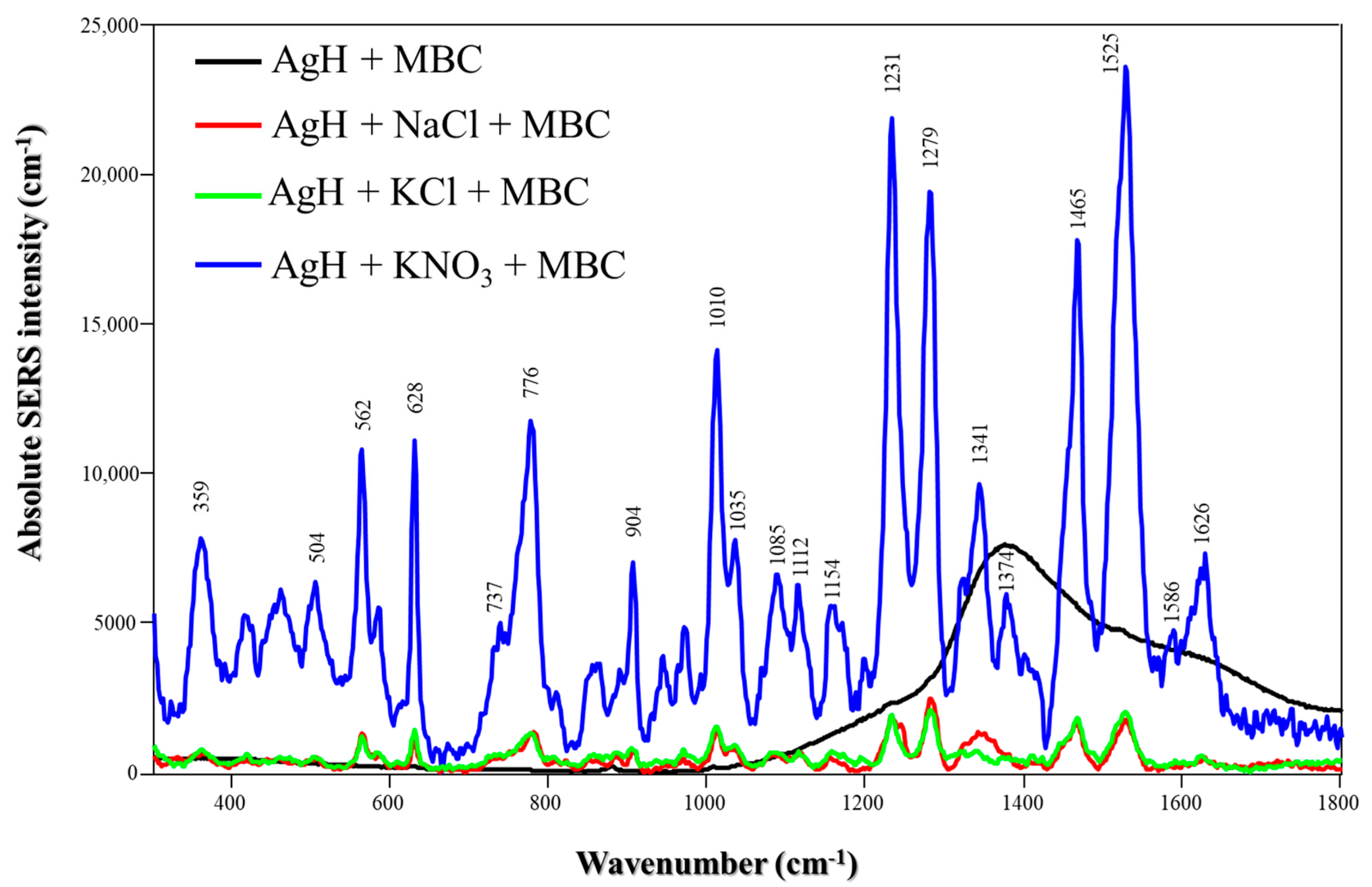
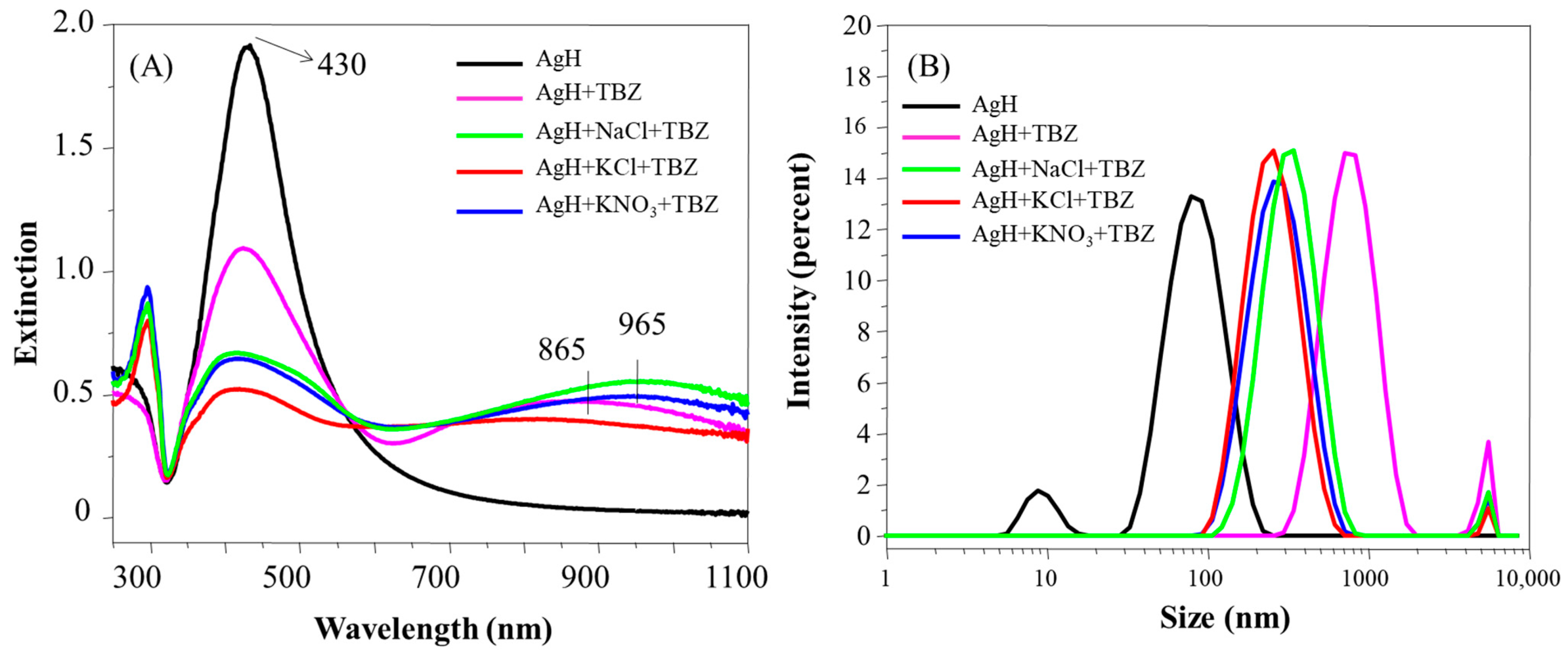
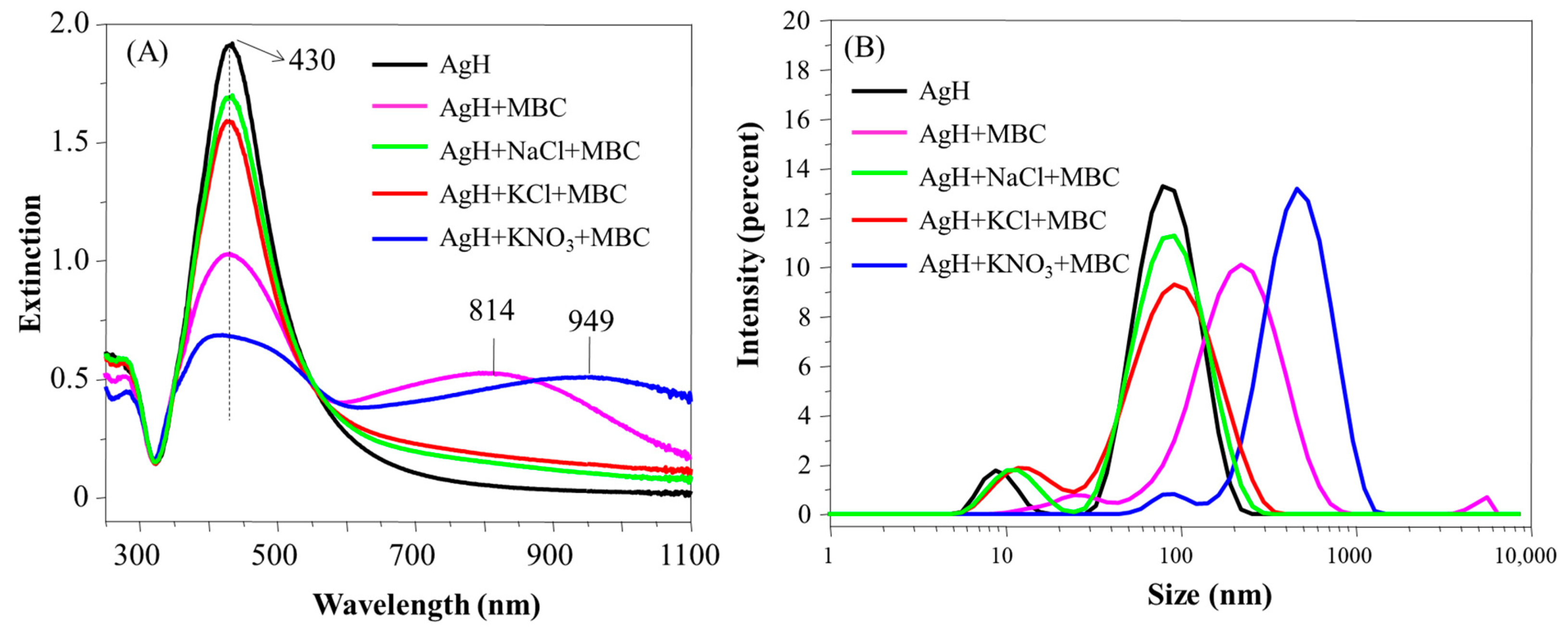
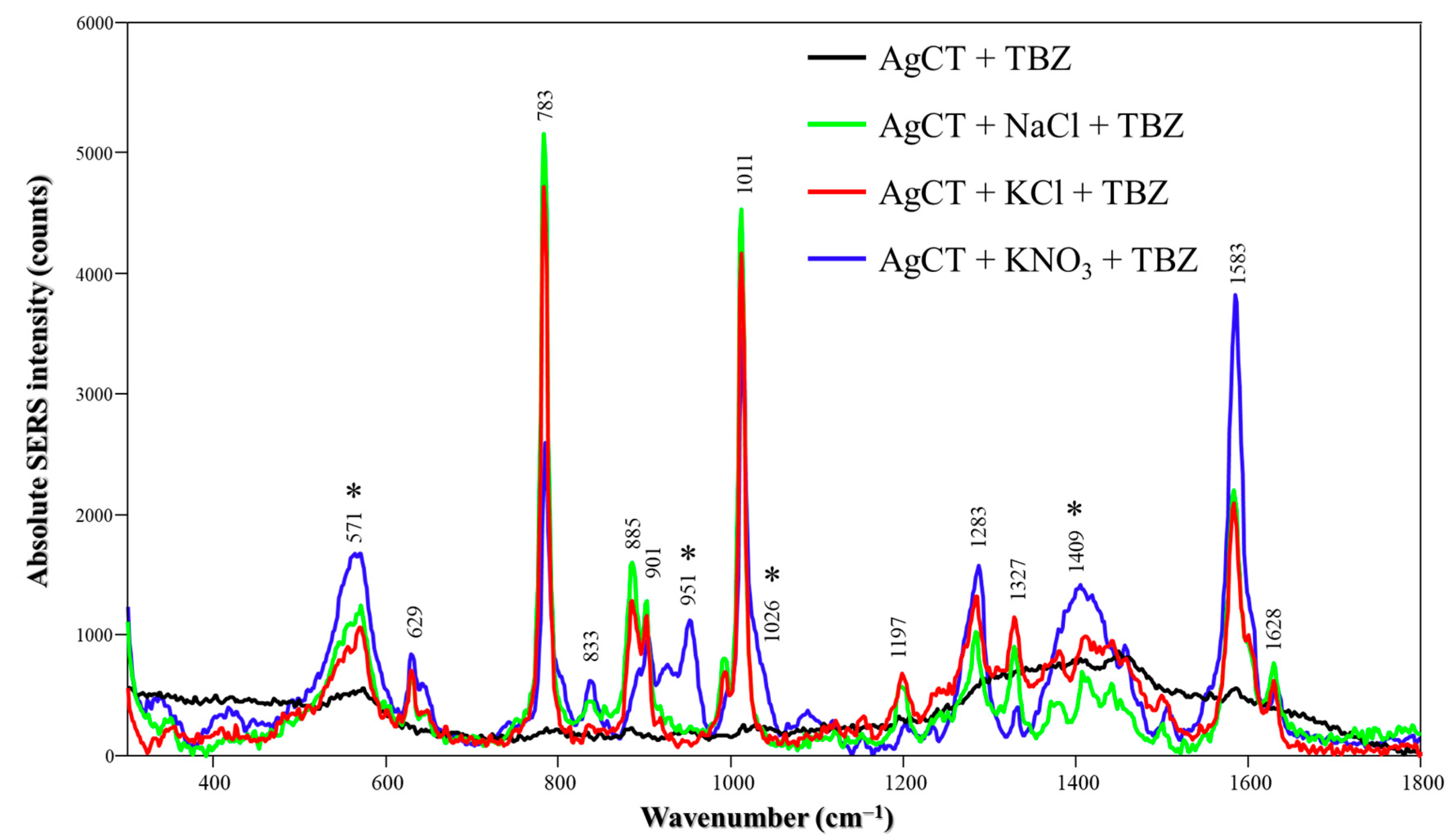

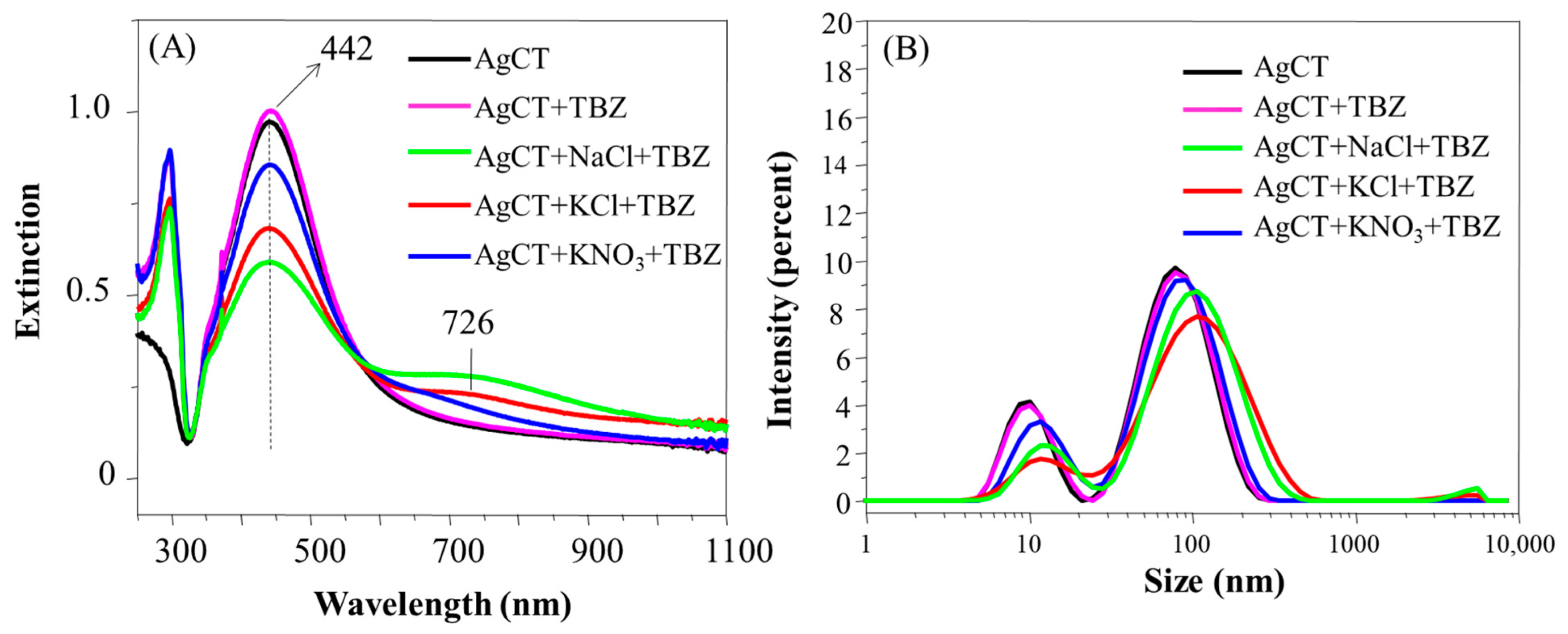

| Sample | PDI | Zeta Potential (mV) |
|---|---|---|
| AgH | 0.301 | −36 ± 1 |
| AgH + KNO3 | 0.410 | −36 ± 2 |
| AgH + KCl | 0.388 | −38 ± 2 |
| AgH + NaCl | 0.387 | −37 ± 2 |
| AgH+ TBZ | 0.368 | 13 ± 1 |
| AgH + KNO3 + TBZ | 0.301 | 18 ± 0.5 |
| AgH + KCl + TBZ | 0.336 | 28 ± 1 |
| AgH + NaCl + TBZ | 0.322 | 13 ± 2 |
| AgH + MBC | 0.378 | −18 ± 1 |
| AgH + KNO3 + MBC | 0.268 | −5 ± 2 |
| AgH + KCl + MBC | 0.495 | −32 ± 1 |
| AgH + NaCl + MBC | 0.331 | −31.0 ± 0.3 |
| Sample | PDI | Zeta Potential (mV) |
|---|---|---|
| AgCT | 0.591 | −32 ± 0.5 |
| AgCT + KNO3 | 0.607 | −28 ± 2 |
| AgCT + KCl | 0.567 | −32 ± 1 |
| AgCT + NaCl | 0.589 | −32 ± 2 |
| AgCT + TBZ | 0.591 | −27 ± 1 |
| AgCT + KNO3 + TBZ | 0.559 | −30 ± 1 |
| AgCT + KCl + TBZ | 0.529 | −25 ± 1 |
| AgCT + NaCl + TBZ | 0.524 | −23 ± 1 |
| AgCT + MBC | 0.591 | −28.0 ± 0.2 |
| AgCT + KNO3 + MBC | 0.550 | −28 ± 1 |
| AgCT + KCl + MBC | 0.569 | −32 ± 1 |
| AgCT + NaCl + MBC | 0.586 | −31 ± 1 |
Disclaimer/Publisher’s Note: The statements, opinions and data contained in all publications are solely those of the individual author(s) and contributor(s) and not of MDPI and/or the editor(s). MDPI and/or the editor(s) disclaim responsibility for any injury to people or property resulting from any ideas, methods, instructions or products referred to in the content. |
© 2025 by the authors. Licensee MDPI, Basel, Switzerland. This article is an open access article distributed under the terms and conditions of the Creative Commons Attribution (CC BY) license (https://creativecommons.org/licenses/by/4.0/).
Share and Cite
Oliveira, M.J.d.S.; Ruiz, G.C.M.; Rubira, R.J.G.; Sanchez-Cortes, S.; Constantino, C.J.L.; Furini, L.N. Consequences of Surface Composition and Aggregation Conditions of Ag Nanoparticles on Surface-Enhanced Raman Scattering (SERS) of Pesticides. Chemosensors 2025, 13, 13. https://doi.org/10.3390/chemosensors13010013
Oliveira MJdS, Ruiz GCM, Rubira RJG, Sanchez-Cortes S, Constantino CJL, Furini LN. Consequences of Surface Composition and Aggregation Conditions of Ag Nanoparticles on Surface-Enhanced Raman Scattering (SERS) of Pesticides. Chemosensors. 2025; 13(1):13. https://doi.org/10.3390/chemosensors13010013
Chicago/Turabian StyleOliveira, Marcelo José dos Santos, Gilia Cristine Marques Ruiz, Rafael Jesus Gonçalves Rubira, Santiago Sanchez-Cortes, Carlos José Leopoldo Constantino, and Leonardo Negri Furini. 2025. "Consequences of Surface Composition and Aggregation Conditions of Ag Nanoparticles on Surface-Enhanced Raman Scattering (SERS) of Pesticides" Chemosensors 13, no. 1: 13. https://doi.org/10.3390/chemosensors13010013
APA StyleOliveira, M. J. d. S., Ruiz, G. C. M., Rubira, R. J. G., Sanchez-Cortes, S., Constantino, C. J. L., & Furini, L. N. (2025). Consequences of Surface Composition and Aggregation Conditions of Ag Nanoparticles on Surface-Enhanced Raman Scattering (SERS) of Pesticides. Chemosensors, 13(1), 13. https://doi.org/10.3390/chemosensors13010013





